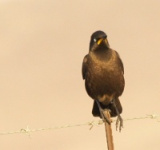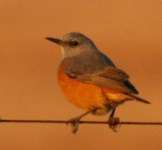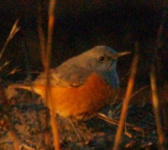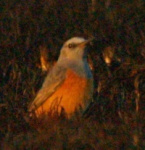



Trip 1: June 2010
One Sunday morning, the 27th of June 2010, we set off from Johannesburg to Durban via Wakkerstroom at 3am. We were off to visit my parents for a week and decided to waste the day birding in Wakkerstroom. We saw three Owls on the way (a Pearl-spotted Owlet, a Spotted Eagle Owl and another that we were not able to id) but the light was too poor to get pics of any of them! We arrived in the town around 6:30am and began by exploring the Over Langberg Larks Loop (we followed the routes explained in Birding Gauteng, chapter 96).
We saw the first of hundreds of Pied Starlings, then Ant-eating Chat, Common Fiscal, Black Shouldered Kite, Red-collared Widowbird, Cape Longclaw and one of the areas� specials: Sentinel Rock-Thrush.
When we arrived at the ruins we first saw two other specials: a pair of Red-winged Francolin, and Buff-streaked Chat. We also saw Red-capped Lark in this area.
Before we got to the T-Junction in an open field on the right side of the road yielded the first Blue Crane that we had ever seen in the wild. They were some distance away but it was still a special experience for us!
We hoped to see the two special Larks in the area (Botha�s and Rudd�s) but our research seemed to indicate that Winter was not a good time for sighting them. We turned right at the T-Junction, making out way towards Frickland Pan, and saw Pied Crow, Cape Wagtail and in the burnt grass areas next to the road saw Spike-heeled Lark and Sacred Bald Ibis.
At Frickland Pan we were somewhat disappointed as we only saw Brown-throated Martin, one Grey Heron, Little Grebe (no Black-necked Grebe unfortunately), Red-knobbed Coot and a Reed Cormorant flying overhead. The scenery made the trip to the pan worthwhile.
We then made our way back towards the town of Wakkerstroom and stopped at the bridge over the wetland. On the water we saw Egyptian Geese, African Spoonbill, Cape Shoveler, Yellow-billed Duck, Little Grebe and Common Moorhen.
Between the road and the water�s edge we saw Purple Swamphen, African Rail, Green-backed Heron and at least five Black-crowned Night-Heron which flew off together at one point � the first time I have seen them in flight.
One of the highlights of this part of the day was taking a walk along the banks of the water and below the road from the hide towards the end of the bridge. It got me up close to African Snipe, Black-crowned Night-Heron and the various ducks that hang around the edge of the water. It is a must-do activity!
As I was scanning the other side of the bridge I saw an African Marsh Harrier flying over the water as well as Purple Heron, Sacred Ibis and Pied Kingfisher.
My son and I took a walk to the hide that is furtherest from the shoreline and along the way spotted Red-throated Wryneck, Half-collared Kingfisher, African Snipe and Speckled Mousebird.
We then explored the northern part of the wetlands around the town � visiting each of the three hides but saw pretty much noting from each hide � in many places the water was frozen all around the hide which would probably limit bird life in the area. It was Sunday and the SA Birdlife offices were unfortunately closed otherwise we would have spent some time there.
We then made our way Paulpietersburg Road and spotted a Black-shouldered Kite and then a Jackal Buzzard which allowed us to park right under where it was perched on a telephone wire. Apart from African Stonechat we did not see much else on the route (we only travelled for about 2 kilometers along the road) � probably because it was around 1:30 by now. On the way back down the road towards town we spotted a Black Harrier flying up and down the stream.
We then headed off to the Zaaihoek Dam and saw two African Fish-Eagle perched next to the water and then flying overhead. At the bridge over the river below the dam wall saw African Darter, Giant Kingfisher, Horus Swift, White-breasted Cormorant and African Black Duck.
We continued to Durban on the dirt road towards Newcastle and enjoyed the scenery along the way.
Some of the other birds spotted on the day include: Bokmakierie, Southern Bald Ibis, Helmeted Guineafowl, South African Shelduck, Cape Robin-Chat, Spur-winged Goose, Green Wood Hoopoe and Cape Weaver.
In total, we saw 69 bird species and recorded 8 Lifers. We considered enlisting the services of a local guide that would certainly have yielded more sightings but we lacked space in our loaded vehicle to accommodate the chap - that we'll do on a return trip.
Trip 2: January 2012
In January 2012 I headed off to Wakkerstroom with two birders (RustyJusty and SafariRanger) for what was effectively my first ever birding safari. We Stayed over for 3 nights in the town at the home of one of the birders Grandparents and spent as much time as possible exploring the various spots in and around the town. By the end of the fourth day we had seen a total of 144 bird species and I had managed to get 7 lifers (Botha's Lark, Common Swift, Red-footed Falcon, Olive Woodpecker, Barratt's Warbler, Black-winged Lapwing, Pallid Harrier) and 2 Photo Lifer (Bush Blackcap and Common House Martin). I also got to see my first ever nest on the ground - one with chicks (African Pipit) and one with eggs (Cape Longclaw).
On two occasions we drove to the top of Ossawakop and I managed to see Yellow-breasted Pipit and Eastern Long-billed Lark on the drive to the beacon (I took a few scenery shots from the top of the mountains looking down on the town below):
One of our major goals was to see both Rudd's Lark and Botha's Lark. We drove to Frickland Pan on our first morning at Wakkerstroom and managed to get quite close to Rudd's Lark in the fields above the pan:
We searched the soccer field on the Over Langberg Loop road in vain but managed to locate Botha's Lark (and Rudd's Lark) on the opposite side of the road in the fields:
You can see something of the dedication it takes to get close to Larks in a field to get decent pics - here RustyJusty has just crept up on his belly to get close to a Botha's Lark and is getting the shot!
One of the highlights was birding in a forest not far out of town - the Jaintjieshoek Link Forest (with a lot of patience - and a little frustratuon at times - I managed to take shots of lifers in the form of Bush Blackcap, Olive Woodpecker and Barratt's Warbler):
Here are some other pics that I took in the forests around Wakkerstroom:
The Cisticola's were out in full force with Zitting and Pale-crowned calling everywhere - and I mean EVERYWHERE!
We searched in vain for Wattled Crane but managed to see the other 2 cranes are numerous occasions:
A sighting on the way in to Wakkerstroom of a Harrier has us all hoping that we managed to see Pallid Harrier:
On the way to Wakkerstroom on the first morning we spotted a small flock of Lapwings in a field and I scored another lifer in the form of Black-winged Lapwing:
A personal highlight was seeing nests on the ground for the first time. We spotted an African Pipit with an insect in it's mouth and with a bit of patience watcher it head to a spot not far from where we had parked, bend down and emerge with nothing in it's mouth - clearly indicating that it had just fed it's chicks. We made our way to the nest sight and took a few pics of the 4 tiny Pipit chicks in the nest:
While we were looking for Botha's Lark in the fields SafariRanger saw a Cape Longclaw fly off a nest and we took some pics of the eggs in the nest:
On the way home from Wakkerstroom to Amersfoort - just before Amersfoort - in a field RustyJusty spotted a rufous coloured Falcon sitting on a fence among Amur Falcon and we were delighted get shots of Red-footed Falcon!
Here is a selection of other sightings that we had:
You can not go birding with RustyJusty and SafariRanger without gaining a new appreciation for the diversity of life in fields and forests:
Here is a full list of the bird species that we saw:
African Black Duck, African Hoopoe, African Jacana, African Marsh-harrier, African Paradise-flycatcher, African Pipit, African Purple Swamphen, African Quailfinch, African Rail, African Snipe, African Spoonbill, African Stonechat, African Wattled Lapwing, Amur Falcon, Banded Martin, Barn Swallow, Barrat's Warbler, Bar-throated Apalis, Black-crowned Night-Heron, Black-headed Heron, Black-shouldered Kite, Blacksmith Lapwing, Black-throated Canary, Black-winged Lapwing, Blue Crane, Blue Korhaan, Bokmakierie, Botha's Lark, Buff-streaked Chat, Bush Blackcap, Cape Bunting, Cape Canary, Cape Crow, Cape Grassbird, Cape Longclaw, Cape Robin-chat, Cape Shoveler, Cape Sparrow, Cape Turtle-Dove, Cape Wagtail, Cape Weaver, Cape White-eye, Cinnamon-breasted Bunting, Common Fiscal, Common Greenshank, Common House-Martin, Common Moorhen, Common Quail, Common Swift, Common Waxbill, Crowned Lapwing, Dark-capped Bulbul, Dark-capped Yellow Warbler, Diderick Cuckoo, Drakensberg Prinia, Eastern Clapper Lark, Eastern Long-billed Lark, Egyptian Goose, African Reed-warbler, Fan-tailed Widowbird, Giant Kingfisher, Glossy Ibis, Great Crested Grebe, Greater Double-collared Sunbird, Greater Kestrel, Greater Striped Swallow, Grey Crowned-crane, Grey Heron, Grey-winged Francolin, Ground Woodpecker, Hadeda Ibis, Hamerkop, Helmeted Guineafowl, Hottentot Teal, Jackal Buzzard, Lanner Falcon, Lazy Cisticola, Lesser Swamp-Warbler, Levaillant's Cisticola, Little Bittern, Little Grebe, Little Rush-Warbler, Little Swift, Long-billed Pipit, Long-tailed Widowbird, Maccoa Duck, Malachite Kingfisher, Malachite Sunbird, Mountain Wheatear, Olive Bush-Shrike, Olive Thrush, Olive Woodpecker, Pale-crowned Cisticola, Pallid Harrier, Pied Kingfisher, Pied Starling, Pin-tailed Whydah, Purple Heron, Red-billed Quelea, Red-billed Teal, Red-capped Lark, Red-chested Cuckoo, Red-collared Widowbird, Red-eyed Dove, Red-footed Falcon, Red-knobbed Coot, Red-throated Wryneck, Red-winged Francolin, Red-winged Starling, Reed Cormorant, Rock Dove, Rock Martin, Rudd's Lark, Secretarybird, Sentinel Rock-Thrush, South African Cliff-Swallow, South African Shelduck, Southern Ant-eating Chat, Southern Bald Ibis, Southern Boubou, Southern Grey-headed Sparrow, Southern Masked-weaver, Southern Red Bishop, Speckled Pigeon, Spike-heeled Lark, Spotted Thick-knee, Spur-winged Goose, Steppe Buzzard, Streaky-headed Seedeater, Three-banded Plover, Village Weaver, Wailing Cisticola, Whiskered Tern, White Stork, White-breasted Cormorant, White-throated Swallow, Wing-snapping Cisticola, Wood Sandpiper, Yellow Bishop, Yellow-billed Duck, Yellow-billed Egret, Yellow-breasted Pipit, Yellow-crowned Bishop and Zitting Cisticola.